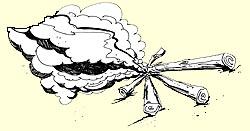Bhagwan Swaminarayan conveyed spiritual truths in the Vachanamrut through
lucid and vivid analogies. |
Introduction
The effectiveness of communication is assessed by the ease with which a message is understood and received for personal integration. Great teachers are renowned for their ability to explain complex ideas in an easy-to-understand way. No matter how involved the idea, with the teacher's command of the subject matter and his effective communication skills, the listener is able to comprehend the idea as easily and effortlessly as he swallows ice cream.
The best teachers are admired for their skill in reducing intricate and bulky ideas into a manageable size for even novice students who have no background of the subject.
Even a cursory study of the Vachanamrut, the main scripture of the Swaminarayan Sampraday, which contain the discourses of Bhagwan Swaminarayan, is enough to convince just how adept and effective a teacher He was.
At a time when the illiterate population of India was twice the literate population, Bhagwan Swaminarayan's simple and lucid teaching style appealed to all stratas of society. From the totally uneducated to distinguished scholars, He conveyed profound spiritual and philosophical ideas so successfully that countless were inspired to live these ideals.
Of the varied techniques used by Bhagwan Swaminarayan, His use of analogies was original, versatile and effective. Using analogies based on day-to-day objects, and often using the same analogy to convey several different ideas, His clarity of thought and effective expression of ideas is apparent, even today, for all to see.
Foundations of Satsang
In the Vachanamrut, Bhagwan Swaminarayan has used dozens of analogies. They have been recorded over a span of ten years 1820-1830 and can be grouped under various subject headings. In this article we take a look at the subject of abhav/avgun, that is, spreading details of other people's negative habits and traits.
In Vachanamrut Loya-5, Shriji Maharaj asks, "Whose foundation in Satsang becomes solid and whose does not?" He Himself replies, "Just as Dattãtreya imbibed the virtues of the five bhuts, the moon, various animals, a prostitute, a virgin, his own body and others, similarly, only if a person has the disposition of imbibing the virtues of a sãdhu does his foundation in Satsang become solid. If a person does not have such a disposition, then even though he remains in Satsang, his foundation is not firm."
The message here is that by appreciating and adopting the virtues of others, one's own spiritual foundations are strengthened. Buildings built upon sturdy foundations are more resilient to natural forces than buildings built upon shaky foundations. Similarly, one who develops a habit of seeking out positive traits in others and imbibing them in his life will be more resilient to the ups-and-downs of daily Satsang life. However, one who has a tendency to merely search for the negative traits in others will suffer from a weak footing in Satsang.
It is often plain for everyone to see that a particular person harbors a particular negative trait, or avgun. It is sometimes so obvious that it jumps right out at us. Is this, then, known as 'taking avgun'? In these situations, and other more subtle cases, the mere act of noticing such negative qualities is not taking avgun. However, to spread this observation or knowledge to others or to contemplate it in one's mind to the extent that one becomes averse to that person is called taking avgun. The important thing to learn is that one's observation should be reported to one's seniors and the responsibility to root out the problem should be left to them. Once reported, one should not circulate details of others' negative qualities.
Such unwarranted gossip has the effect of creating enemies, disunity and instability. These factors combine to hinder one's own spiritual development. Thus, it is to prevent such unwanted consequences that Shriji Maharaj has, in over 80 Vachanamruts, warned against taking the avgun of others and has encouraged the adoption of others' guns. He has emphasized His view by the use of vivid analogies to point out the harm in taking avguns.
Half-Burnt Log of Wood
In Vachanamrut Gadhada I-28, Shriji Maharaj says, "When a satsangi is likely to regress in the Satsang fellowship, vicious desires steadily flourish within him.
 At first, he begins to perceive flaws in all of the satsangis day by day. In his heart, he feels, 'All of these satsangis lack understanding; only I have true understanding.' In this way, he considers himself to be superior to all. Such a person remains constantly uneasy, day and night. He cannot sit peacefully anywhere during the day; nor can he sleep at night. Moreover, his anger never subsides. In fact, he constantly smolders like a half-burnt log. A person who behaves in this manner should be known to be on the verge of falling out of Satsang. No matter how many days he spends in Satsang, he will never experience peace in his heart; ultimately, he will fall from Satsang."
At first, he begins to perceive flaws in all of the satsangis day by day. In his heart, he feels, 'All of these satsangis lack understanding; only I have true understanding.' In this way, he considers himself to be superior to all. Such a person remains constantly uneasy, day and night. He cannot sit peacefully anywhere during the day; nor can he sleep at night. Moreover, his anger never subsides. In fact, he constantly smolders like a half-burnt log. A person who behaves in this manner should be known to be on the verge of falling out of Satsang. No matter how many days he spends in Satsang, he will never experience peace in his heart; ultimately, he will fall from Satsang."
In this analogy, Shriji Maharaj uses the example of a smoldering log of wood, which is the cause of much irritation and discomfort because of the smoke it gives off. The smoke irritates the eyes and throat and results in much trouble. Similarly, a person who takes avguns of others is simmering with malice. His words spread trouble. His damaging remarks cause discomfort and he himself feels uncomfortable. Just like the smoldering log which is unable to burn out completely or be extinguished, a person who takes avguns is neither able to extinguish his habit nor fully restrain himself from irritating others. Thus, such a person, will sooner or later fall from the spiritual path.
Poisoned Milk
The poisoned milk analogy has been used by Shriji Maharaj on seven occasions throughout the Vachanamrut - each time to explain a different concept.
In Vachanamrut Gadhada I-35, Shriji Maharaj says, "Suppose there is some tasty buffalo-milk in which sãkar has been dissolved. Now if a snake's venom were to fall in it, then that same milk and sãkar would become poisonous. Thereafter, whoever drinks it would die. Similarly, such a person may be highly intelligent, but he has perceived a flaw in the great Sant or God. This drawback, in the form of perceiving a flaw, has entered his mind and is comparable to the snake's venom. So how can he possibly walk on the path of liberation? In fact, even if someone were to listen to his talks, the listener's mind would also fall back from Satsang. Moreover, wherever a person possessing such a polluted intellect takes birth, he always maligns God or His devotees. Conversely, a person whose intellect is not polluted in this manner, even if he has little intelligence, does not falter in safeguarding his own liberation."
Here, the milk represents the sharp intelligence of a person and the snake venom represents the negative habit of taking avgun which has infected that person. So, even though such a person is smart, his harmful habit poisons his mind, ultimately leading to his spiritual ruin - just as someone who drinks the poisoned milk will die. The key to keeping the mind pure is to avoid, totally, taking the avgun of others.
Decapitation
Shriji Maharaj explains in Vachanamrut Loya-7, "One who harbors an aversion towards the Sant is unable to become pure by any form of atonement.
 In fact, release from the sins of lust and other vices is possible, but release from the sin of maligning the Sant is not possible. For example, if a person contracts tuberculosis, no medicine would be able to cure the disease; he would definitely die. Similarly, one who harbors an aversion towards the Sant should be known as having tuberculosis; he will certainly fall from Satsang sometime in the future. Furthermore, even if a person's hands, feet, nose, eyes, fingers and other body parts are severed, he still cannot be described as dead. However, when the head is severed from the body, he is described as dead. Similarly, he who perceives flaws in a devotee of God has had his head severed. If he lapses in following other religious vows, then his limbs can be said to be severed - but he will still live. That is, he will survive in Satsang. But a person who has perceived flaws in the Sant will certainly, at some time, fall from Satsang. He should be known to have his head severed."
In fact, release from the sins of lust and other vices is possible, but release from the sin of maligning the Sant is not possible. For example, if a person contracts tuberculosis, no medicine would be able to cure the disease; he would definitely die. Similarly, one who harbors an aversion towards the Sant should be known as having tuberculosis; he will certainly fall from Satsang sometime in the future. Furthermore, even if a person's hands, feet, nose, eyes, fingers and other body parts are severed, he still cannot be described as dead. However, when the head is severed from the body, he is described as dead. Similarly, he who perceives flaws in a devotee of God has had his head severed. If he lapses in following other religious vows, then his limbs can be said to be severed - but he will still live. That is, he will survive in Satsang. But a person who has perceived flaws in the Sant will certainly, at some time, fall from Satsang. He should be known to have his head severed."
Although observance of ones dharma is a must for spiritual progress, Shriji Maharaj uses this analogy to emphasize the essential need to avoid taking avguns of others. The fact that lapses in dharma can be atoned for is illustrated by Shriji Maharaj's comparison of such lapses to merely a non-fatal injury to the body - it causes pain and damage - but does not cause death.
However, taking avgun of others is likened to having one's head chopped off and indicates certain spiritual death. It is fatal to one's chances of spiritual progress.
Fish Out of Water
In the same Vachanamrut, Loya-1, Shriji Maharaj further explains, "As long as the aversion towards the Sant is not removed from the person's heart, he would experience extreme remorse, just like a fish would suffer without water."
Here, Shriji Maharaj explains that just as a fish which is displaced from its life-supporting water environment struggles to survive, a person who harbors avguns for others will similarly struggle to survive in Satsang.
Rabid Dog
In Vachanamrut Gadhada III-12, Shriji Maharaj says, "Even though he may be called a satsangi, a person who has perceived faults in God or His Bhakta should be known to be like a rabid dog. Just as one who is touched by the saliva of a rabid dog also becomes rabid, similarly, if one listens to the talks of or keeps affection for one who has perceived faults in God or His Bhakta, then both the person who keeps the affection as well as the listener become like a non-believer."
As everyone knows a rabid dog is a menace to all. Whoever it bites will be infected with rabies - which without treatment is often fatal. This analogy highlights just how dangerous and infective people who take avguns are. They themselves are already infected with this dangerous habit and whoever they bite - through their talks - are also likely to become infected with negative thoughts that will ultimately lead to their spiritual demise. Thus, like rabid dogs they are a menace to all who come in their contact.
Discussion
Through all these analogies, and others, Shriji Maharaj has shown us the path of spiritual survival and progress. By indulging in taking avguns we invite decline, so the obvious path to follow is to seek out and adopt the virtues (guns) of others to strengthen our foundations and enhance our spiritual standing.
Thus, the tendency to take avguns of others prevents the enjoyment of Satsang. Yogiji Maharaj used to say that the 'taste' of Satsang is like the taste of sweet kesar mangoes. However, the habit of taking avguns sours the taste - that is, it sours our enjoyment of Satsang.
Even though Shriji Maharaj launched these ideas and concepts nearly 200 years ago, they are still as relevant today. They are the bedrock of harmony in one's professional and personal life. Everyone is well aware of the effect of office gossip. Such rumors generate nothing but enmity, distrust and disunity, thus affecting one's output.
The principle, in theory, is simple but the temptation to draw attention to others' negative qualities is often overwhelming and even those of high spiritual standing have succumbed to it, and consequently fallen from Satsang. Constant awareness is necessary to ensure that one's hard-earned spiritual merits are not wiped out by the trivial and inconsequential habits and traits of others.
The dark side of human nature is to see or find faults in others. To lessen and eradicate this fatal attribute one has to engage oneself to satsang, reading, discourses and, introspection, prayer and confession to the Satpurush.